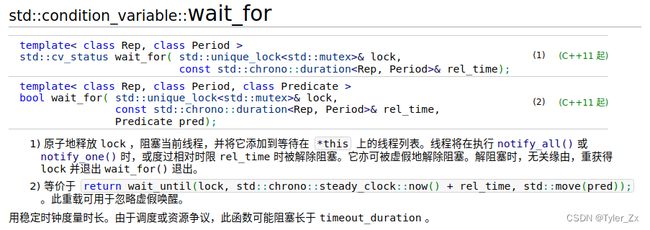C++ mutex 与 condition_variable
导语:整理以下多线程的互斥与同步。
mutex 使用起来很简单,需要处理一段临界区代码时,只要调用 lock 或 try_lock 即可。lock 和 unlock 是没有返回值的,try_lock 的返回值是一个 bool,它用于尝试锁定互斥,成功返回 true,失败返回 false。
#include
#include
#include
#include
std::chrono::milliseconds interval(100);
std::mutex mutex;
int job_shared = 0; // 两个线程都能修改 'job_shared',mutex 将保护此变量
int job_exclusive = 0; // 只有一个线程能修改 'job_exclusive'
// 此线程能修改 'job_shared' 和 'job_exclusive'
void job_1() {
std::this_thread::sleep_for(interval); // 令 'job_2' 持锁
while (true) {
// 尝试锁定 mutex 以修改 'job_shared'
if (mutex.try_lock()) {
std::cout << "job shared (" << job_shared << ")\n";
mutex.unlock();
return;
} else {
// 不能获取锁以修改 'job_shared'
// 但有其他工作可做
++job_exclusive;
std::cout << "job exclusive (" << job_exclusive << ")\n";
std::this_thread::sleep_for(interval);
}
}
}
// 此线程只能修改 'job_shared'
void job_2() {
mutex.lock();
std::this_thread::sleep_for(5 * interval);
++job_shared;
mutex.unlock();
}
int main() {
std::thread thread_1(job_1);
std::thread thread_2(job_2);
thread_1.join();
thread_2.join();
return 0;
}
可能的输出结果:
job exclusive (1)
job exclusive (2)
job exclusive (3)
job exclusive (4)
job shared (1) job_2 会先持有锁,所以 job_1 内的 while 循环会先递增 job_exclusive 的值,直到 job_2 处理完后释放锁,才会打印 job_shared 的值。
#include
#include
#include
#include
#include
#include
std::mutex m;
std::condition_variable cv;
std::string data;
bool ready = false;
bool processed = false;
void worker_thread() {
// 等待直至 main() 发送数据
std::unique_lock lk(m);
cv.wait(lk, []{return ready;});
// 等待后,我们占有锁。
std::cout << "Worker thread is processing data\n";
data += " after processing";
// 发送数据回 main()
processed = true;
std::cout << "Worker thread signals data processing completed\n";
// 通知前完成手动解锁,以避免等待线程才被唤醒就阻塞(细节见 notify_one )
lk.unlock();
cv.notify_one();
}
int main() {
std::thread worker(worker_thread);
std::cout << "wait for a moment" << std::endl;
std::this_thread::sleep_for(std::chrono::seconds(1));
data = "Example data";
// 发送 ready 信号到 worker 线程
{
std::lock_guard lk(m);
ready = true;
std::cout << "main() signals data ready for processing\n";
}
cv.notify_one();
// 等候 worker
{
std::unique_lock lk(m);
cv.wait(lk, []{return processed;});
}
std::cout << "Back in main(), data = " << data << '\n';
worker.join();
return 0;
} 在 worker_thread 内获取了互斥锁,但是真正的执行要等到 main 函数中触发 notify_one 才真正开始。
#include
#include
#include
#include
std::condition_variable cv;
std::mutex cv_m;
int i = 0;
bool done = false;
void waits() {
std::unique_lock lk(cv_m);
std::cout << "Waiting... \n";
cv.wait(lk, []{return i == 1;});
std::cout << "...finished waiting. i == 1\n";
done = true;
}
void signals() {
std::this_thread::sleep_for(std::chrono::seconds(1));
std::cout << "Notifying falsely...\n";
cv.notify_one(); // 等待线程被通知 i == 0.
// cv.wait 唤醒,检查 i ,再回到等待
std::unique_lock lk(cv_m);
i = 1;
while (!done)
{
std::cout << "Notifying true change...\n";
lk.unlock();
cv.notify_one(); // 等待线程被通知 i == 1 , cv.wait 返回
std::this_thread::sleep_for(std::chrono::seconds(1));
lk.lock();
}
}
int main()
{
std::thread t1(waits);
std::this_thread::sleep_for(std::chrono::milliseconds(100));
std::thread t2(signals);
t1.join();
t2.join();
return 0;
}
#include
#include
#include
#include
#include
using namespace std::chrono_literals;
std::condition_variable cv;
std::mutex cv_m;
int i;
void waits(int idx) {
std::unique_lock lk(cv_m);
if(cv.wait_for(lk, idx*100ms, []{return i == 1;}))
std::cerr << "Thread " << idx << " finished waiting. i == " << i << '\n';
else
std::cerr << "Thread " << idx << " timed out. i == " << i << '\n';
}
void signals() {
std::this_thread::sleep_for(120ms);
std::cerr << "Notifying...\n";
cv.notify_all();
std::this_thread::sleep_for(100ms);
{
std::lock_guard lk(cv_m);
i = 1;
}
std::cerr << "Notifying again...\n";
cv.notify_all();
}
int main() {
std::thread t1(waits, 1), t2(waits, 2), t3(waits, 3), t4(signals);
t1.join(); t2.join(), t3.join(), t4.join();
}
输出:
Thread 1 timed out. i == 0
Notifying...
Thread 2 timed out. i == 0
Notifying again...
Thread 3 finished waiting. i == 1 std::lock_gaurd 和 std::unique_lock 的区别
lock_guard:没有提供加锁和解锁的接口。通过构造函数和析构函数控制锁的作用范围,创造对象的时候加锁,离开作用域的时候解锁;
unique_lock:提供了 lock() 和 unlock() 接口,可以通过构造函数和析构函数控制锁的作用范围。在构造函数中延时加锁,可以在需要的时候手动加锁和解锁。在析构的时候,会根据当前状态来决定是否要进行解锁(lock_guard 就一定会解锁)。
#include
#include
#include
struct Box {
explicit Box(int num) : num_things{num} {}
int num_things;
std::mutex m;
};
void transfer(Box &from, Box &to, int num) {
// don't actually take the locks yet
std::unique_lock lock1{from.m, std::defer_lock};
std::unique_lock lock2{to.m, std::defer_lock};
// lock both unique_locks without deadlock
std::lock(lock1, lock2);
from.num_things -= num;
to.num_things += num;
// 'from.m' and 'to.m' mutexes unlocked in 'unique_lock' dtors
}
int main() {
Box acc1{100};
Box acc2{50};
std::thread t1{transfer, std::ref(acc1), std::ref(acc2), 10};
std::thread t2{transfer, std::ref(acc2), std::ref(acc1), 5};
t1.join();
t2.join();
std::cout << "acc1: " << acc1.num_things << "\\n"
"acc2: " << acc2.num_things << '\\n';
}
std::mutex mu;
void Test() {
int b = 1;
std::unique_lock lock(mu, std::defer_lock);
lock.lock();
b++;
lock.unlock();
cout << "b: " << b << endl;
}
使用 unique_lock 时,设置 std::defer_lock 才能手动加锁,没有设置则不能。延迟加锁的设置不会影响解锁,不管有没有设置都可以手动解锁。而 lock_guard 则没有加锁和解锁的接口。
std::shared_mutex
shared_mutex 是 C++ 的原生读写锁实现,有共享和独占两种锁模式,适用于并发高的读场景下,通过 reader 之前共享锁来提升性能。在 C++17 之前,只能自己通过独占锁和条件变量自己实现读写锁或使用 C++14 加入的性能较差的 std::shared_timed_mutex。以下是通过 shared_mutex 实现的线程安全计数器:
#include
#include // 对于 std::unique_lock
#include
#include
class ThreadSafeCounter {
public:
ThreadSafeCounter() = default;
// 多个线程/读者能同时读计数器的值。
unsigned int get() const {
std::shared_lock lock(mutex_);
return value_;
}
// 只有一个线程/写者能增加/写线程的值。
void increment() {
std::unique_lock lock(mutex_);
value_++;
// 可以在程序结尾处手动解锁
}
// 只有一个线程/写者能重置/写线程的值。
void reset() {
std::unique_lock lock(mutex_);
value_ = 0;
}
private:
mutable std::shared_mutex mutex_;
unsigned int value_ = 0;
};
int main() {
ThreadSafeCounter counter;
std::mutex mutex_;
auto increment_and_print = [&counter, &mutex_]() {
for (int i = 0; i < 3; i++) {
counter.increment();
std::lock_guard lock(mutex_);
std::cout << std::this_thread::get_id() << ' ' << counter.get() << '\\n';
// 注意:写入 std::cout 实际上也要由另一互斥同步。省略它以保持示例简洁。
}
};
std::thread thread1(increment_and_print);
std::thread thread2(increment_and_print);
thread1.join();
thread2.join();
}



